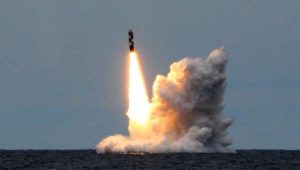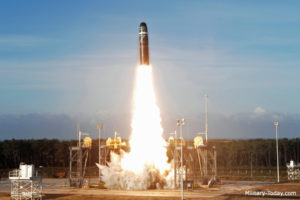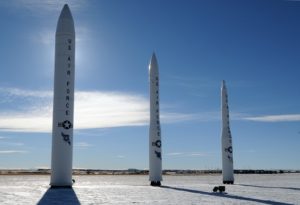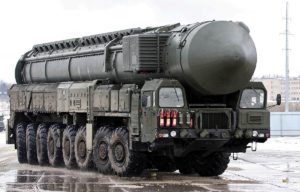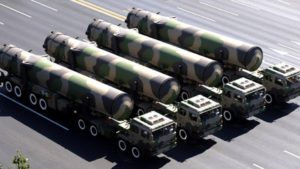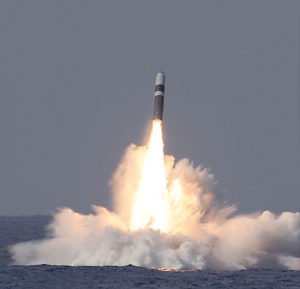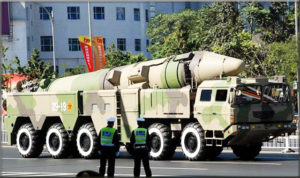Intercontinental Ballistic Missiles (ICBMs) are a major nuclear deterrent and only a few nations possess the technology to launch such long-range weaponry.Here we lists the top 10 ICBMs by range.
10 – RSM-56 Bulava, Russia
The Bulava or RSM-56 (NATO code name: SS-NX-32) is a new intercontinental-range, submarine-launched ballistic missile of the Russian Navy. The missile, with a range of about 10,000km, is intended for Borey-class nuclear submarines. The Bulava missile was inducted into service aboard the Yuri Dolgorukiy submarine in January 2013. Each missile can carry six to ten individually targeted nuclear warheads with a yield of 100kt-150kt. The throw weight of the missile is about 1,150kg. The missile uses solid fuel for first two stages and liquid fuel for the third stage. It is designed to survive nuclear explosions at a minimum range of 500m.
9 –UR-100N, Russia
The UR-100N (NATO reporting name: SS-19 Stiletto) is the fourth generation ICBM in service with the Russian Strategic Rocket Forces. The striking range of 10,000km makes it one of the longest range ICBMs in the world. The UR-100N was put into service in 1975 and is expected to remain operational until 2030. It carries up to six MIRV warheads with yield of 550kt each. It employs inertial guidance system for accurate engagement of targets. The two-stage missile is launched from silos. The rocket motors utilise storable liquid propellant comprising of UDMH and Nitrogen Tetroxide.
8 –M51 ICBM, France
The M51 is an intercontinental range submarine-launched ballistic missile produced by EADS Astrium Space Transportation, for the French Navy. Designed to replace the M45 SLBM (the MSBS or Mer-Sol-Balistique-Stratégique in French, meaning “Sea-ground-Strategic ballistic”), it was first deployed in 2010. The missile was inducted into service aboard the French Navy’s Triomphant class submarines in 2010. Its operational range is between 8,000km and 10,000km. An improved version with new nuclear warheads is scheduled for commissioning in 2015. The M51 weighs 50t and can carry six independently targetable re-entry vehicles with a yield of 100kt-150kt each. A solid rocket motor integrating a flex-bearing nozzle powers the three-stage missile.
7 –Minuteman-III, US
The Minuteman-III (LGM-30G) with a range of over 6,000nmi (10,000km) is one of the world’s longest-range nuclear missiles in service. It is the only operational land-based ICBM in the US military armoury. The Minuteman range of ICBMs was manufactured by Boeing for the Air Force Combat Command. Minuteman I was launched in February 1961, while the improved II and III versions were launched in 1964 and 1968 respectively. Minuteman III, the first operational missile of the Minuteman range, was accepted into service by Minot Air Force Base in June 1970. It also was the first missile in history to carry multiple warheads through a multiple re-entry vehicle (MRV) system. The missile weighs about 76,000lb (34,473kg) and is powered by three-stage solid fuel rocket motors. The solid-fuelled propulsion system ensures the missile to cruise at a speed of 15,000mph (24,140km/h).
6 – RT-2UTTKh Topol-M, Russia
The RT-2UTTKh Topol-M with a range of about 11,000km is an advanced version of the Topol ICBM. These nuclear missiles are launched either from silos or mobile launchers and can carry a single 550kt warhead. The 47.2mt missile was developed by the Moscow Institute of Thermal Technology (MITT) and assembled at the Votkinsk Machine Building Plant. It is the first ICBM to be developed after the Soviet Union’s dissolution. The missile has been designed to withstand radiation, electromagnetic pulse and nuclear explosions at ranges over 500m and can also survive hits from high-energy lasers. The Topol-M can also carry four to six MIRV warheads along with decoys. The three-stage rocket motors utilise solid propellant to propel the missile to a maximum speed of 7,320m/s.
5 –DongFeng 31 A,China
The DongFeng 31A or DF-31A (NATO reporting name: CSS-9 Mod-2) is a Chinese long-range intercontinental ballistic missile with a range of 11,200km. These nuclear missiles can carry a single thermal nuclear warhead of 1,000kt. The extended-range missile was developed based on the DF-31 ICBM. The PLA Second Artillery Corps has introduced 10 DF-31A missiles into service since 2006. A submarine-launched Julang-2 (JL-2) missile is also being developed from the land-based DF-31. The DongFeng 31A can be launched from silos or transported on a transporter-erector-launcher (TEL) vehicle. The three-stage missile, with a launch weight of 42t, is propelled by solid-propellant rocket motors.
4 –UGM-133 Trident II, US
UGM-133 Trident II is a submarine launched ballistic missile (SLBM) with ICBM-class range. It is currently deployed by the US Navy’s Ohio and British Vanguard Class submarines. The Trident II D5 Life Extension (LE) version is expected to be in service onboard the Ohio-class SSBNs until 2042. The first UGM-133 missile was launched from a pad at Cape Canaveral in January 1987. These nuclear missiles entered into the US Navy’s service in 1990 and can carry up to eight multiple W88 or W76 nuclear warheads. Propulsion is provided by three solid-propellant rocket motors providing a range of over 7,000 miles (11,300km). ATK supplied boost motor systems for the three stages for the prime contractor Lockheed Martin Space Systems. The missile can travel at over 13,000mph.
3 –R-29RMU Sineva,Russia
R-29RMU Sineva, also known as RSM-54 (NATO code name: SS-N-23 Skiff), is a Russian third-generation, submarine-launched ICBM. The missile can be carried by Delta IV class submarines of the Russian Navy. Sineva reached a maximum range of 11,547km during tests. The missile was inducted into service in 2007 and is expected to be operational until 2030. It can carry four warheads or ten 100kt warheads through independently targetable re-entry vehicles. It employs astro-inertial control and GLONASS navigation systems to engage targets with high-accuracy. The three-stage missile is powered by liquid propellant engines which use UDMH and Nitrogen Tetroxide as fuel and oxidiser respectively.
2 – DongFeng 5A,China
DongFeng 5A (NATO reporting name: CSS-4) is China’s longest range ICBM and is capable of striking targets within the range of 13,000km. It is an improved version of the 12,000km-range DF-5 ICBM and is capable of reaching targets within the continental United States (CONUS). China inaugurated the improved DF-5A with long range and more accurate guidance system in 1983. The throw-weight of the missile was also increased from 3,000kg to 3,200kg. The missile can carry six re-entry vehicles weighing 600kg each. The DF-5A ICBM is fired from launch pad or land-based silo. Inertial guidance system and on-board computers provide direction to the missile. Two-stage rocket engines using a liquid bi-propellant provide the required propulsion.
1 – R-36M, Russia
The R-36M (SS-18 Satan) is the world’s longest range Intercontinental Ballistic Missile (ICBM) with a range of 16,000km. With a weight of 8.8t the R-36M is also the heaviest ICBM in the world. The R-36M has been built in different versions ranging from Mod 1 to Mod 6. The variants were designed for firing from silo-based launch sites. Some of the R-36M versions are capable of carrying ten Multiple Independent Re-entry Vehicles (MIRV) warheads with 550 kilo tonne (kt) to 750kt of yield each. The first R-36M Mod 1 variant was deployed by the Soviet Union Strategic Rocket Forces in 1975. The two-stage rocket is powered by liquid rocket engines providing a speed of about 7.9km/sec. The engines utilise storable liquid propellant with Unsymmetrical dimethylhydrazine (UDMH) fuel and Nitrogen Tetroxide acting as an oxidiser.

